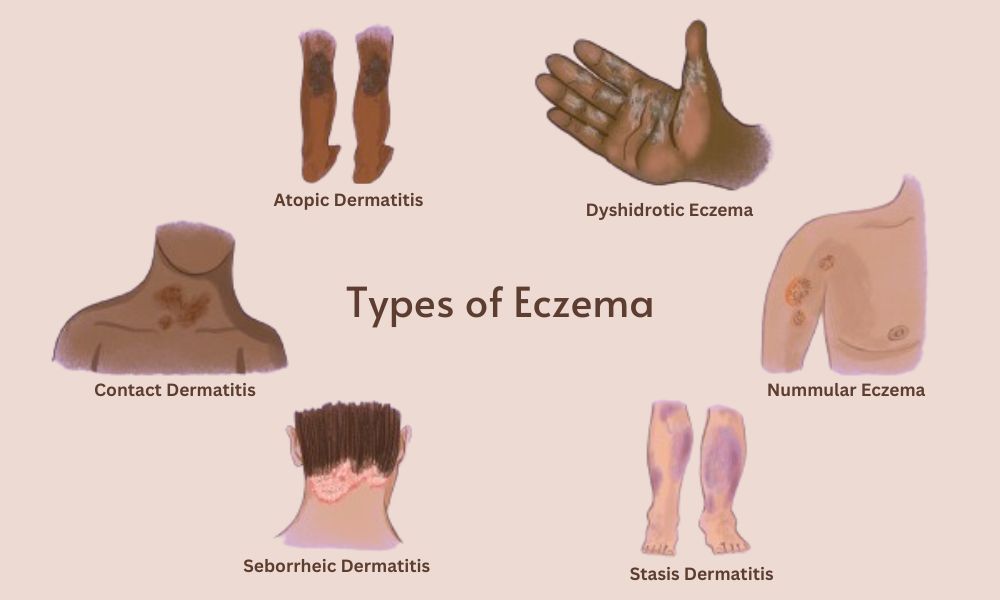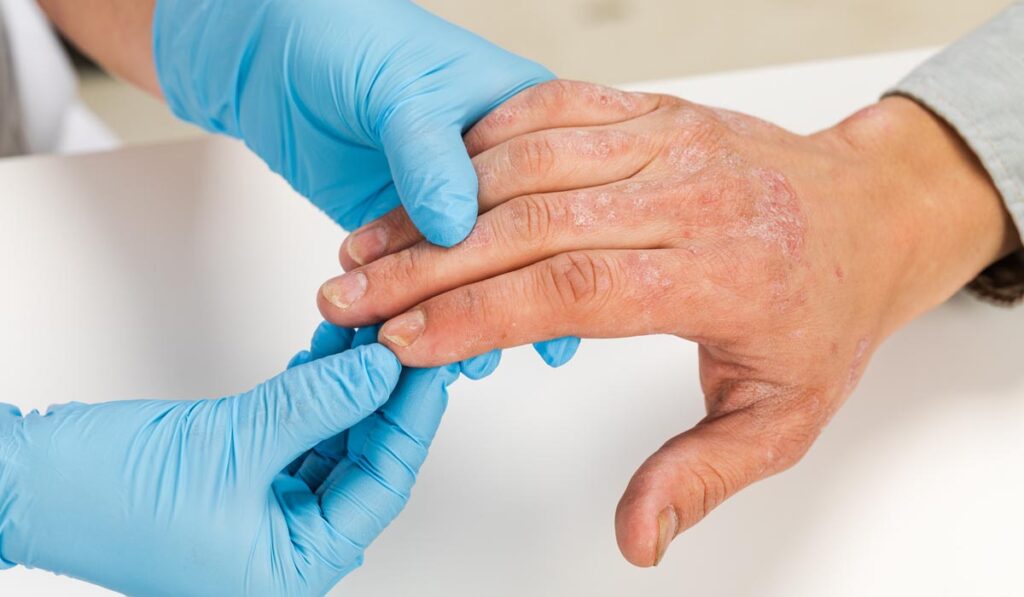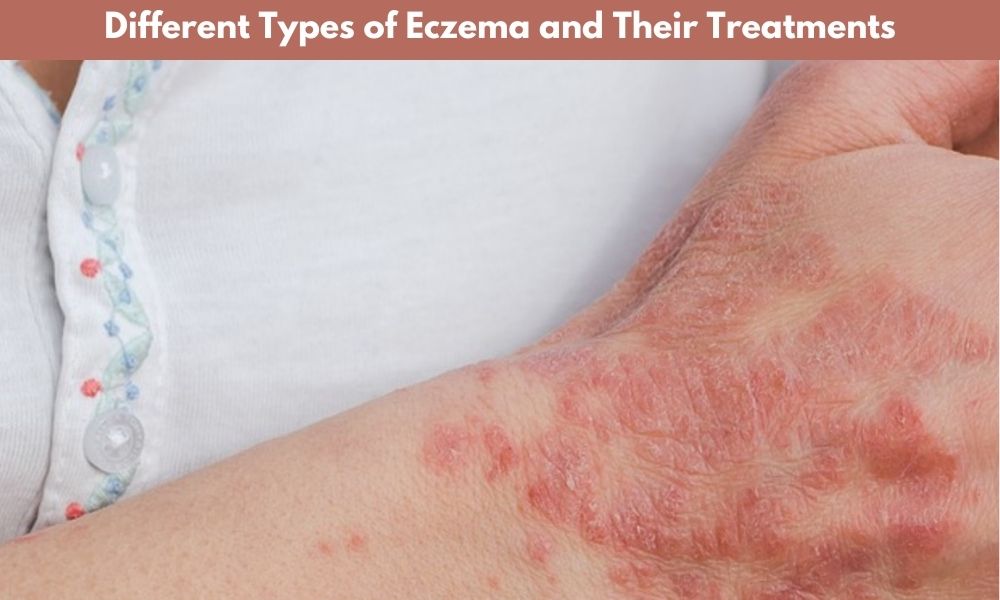What is Eczema?
Eczema is a long-term skin condition that causes inflammation, redness, and itching. It’s also called dermatitis. It affects many people around the world and can greatly affect their quality of life. The exact cause of eczema is not found, but it is believed to involve a combination of genetic and environmental factors. It often runs in families and is linked to other atopic conditions such as asthma and hay fever. Understanding the different types of eczema and their respective treatments is crucial for effective management and relief from symptoms.
Common symptoms of eczema include:
- Dry, sensitive skin
- Red, inflamed skin
- Intense itching
- Dark-colored patches of skin
- Rough, leathery, or scaly patches of skin
- Oozing or crusting
- Areas of swelling
Eczema can appear anywhere on the body but is most found on the face, neck, hands, and legs.
Types of Eczema

1. Atopic Dermatitis
Atopic dermatitis is the most common type of eczema. It usually starts in childhood and potentially continues into adulthood. It is part of the “atopic triad,” which includes asthma and hay fever. The symptoms include dry, itchy skin, and red or brownish-gray patches, particularly on the hands, feet, ankles, wrists, neck, upper chest, eyelids, and in the creases of the elbows and knees. Small, raised bumps may leak fluid and crust over when scratched, leading to thickened, cracked, or scaly skin.
Treatment for atopic dermatitis involves regular use of emollients to keep the skin hydrated, and topical corticosteroids to reduce inflammation and itching. Antihistamines can help alleviate severe itching, and immunomodulators like tacrolimus and pimecrolimus are used for moderate to severe cases.
2. Contact Dermatitis
Contact dermatitis occurs when the skin comes into contact with an irritant or allergen, leading to an inflammatory reaction. Symptoms include a red, itchy rash, blisters or bumps, and a burning or stinging sensation. There are two types: irritant contact dermatitis and allergic contact dermatitis.
Treatment involves identifying and avoiding the irritant or allergen, using topical corticosteroids to reduce inflammation, and applying moisturizers to repair the skin barrier. Antibiotics may be necessary for secondary infections if the skin is broken.
3. Dyshidrotic Eczema
Dyshidrotic eczema affects the hands and feet, causing small, intensely itchy blisters. The skin may become red, cracked, or scaly.
To treat dyshidrotic eczema, you can use cold compresses to reduce itching and inflammation. Moisturizers help keep the skin hydrated. For severe cases, topical corticosteroids are often used. For chronic cases, phototherapy, or light therapy, can be helpful.
4. Nummular Eczema
Nummular eczema presents as circular, coin-shaped spots on the skin, often after a skin injury. Symptoms include round, red, or brown patches, itching and burning sensations, and crusty or oozing spots.
Treatment involves using moisturizers to prevent dry skin, topical corticosteroids to reduce inflammation, and antibiotics for infected lesions. Avoiding irritants and allergens is also crucial.
5. Seborrheic Dermatitis
Seborrheic dermatitis affects areas with a high concentration of sebaceous (oil) glands, such as the scalp and face. Symptoms include red, greasy skin with white or yellowish scales and dandruff.
Treatment involves using medicated shampoos containing ingredients like ketoconazole or selenium sulfide, topical antifungals to reduce yeast overgrowth, topical corticosteroids to reduce inflammation, and calcineurin inhibitors for sensitive areas like the face.
6. Stasis Dermatitis
Stasis dermatitis occurs in the lower legs due to poor blood circulation, often in individuals with varicose veins. Symptoms include swelling in the lower legs, red, itchy, scaly skin, and in severe cases, ulcers.
Treatment includes wearing compression stockings to improve blood flow, using moisturizers to keep the skin hydrated, applying topical corticosteroids for inflammation, and elevating the legs to reduce swelling.
General Eczema Management Tips

1. Skincare Routine
Maintaining a proper skincare routine is important for managing eczema. Regularly moisturizing the skin can prevent dryness and flare-ups. Use mild, fragrance-free cleansers and moisturizers to avoid irritation.
2. Avoiding Triggers
Identify and avoid triggers that can cause eczema flare-ups. Common triggers include certain foods, environmental allergens, harsh soaps, and stress.
3. Dietary Adjustments
Some individuals find relief by adjusting their diet. Incorporating anti-inflammatory foods and avoiding allergens like dairy, gluten, and nuts can help manage symptoms.
4. Stress Management
Stress can make eczema symptoms worse. To help reduce stress, try relaxation techniques like yoga, meditation, and deep breathing exercises.
5. Medical Consultation
Regular check-ups with a dermatologist are essential for managing eczema. A healthcare professional can provide personalized treatment plans and adjust medications as needed.
Conclusion:
Eczema is a complex condition with various types, each requiring specific treatments. Understanding the different types of eczema and their treatments can help individuals manage their symptoms effectively and improve their quality of life. If you suspect you have eczema or your current treatment isn’t providing relief, consult a Dermatologist or Eczema Specialist in Mumbai to explore the best treatment options.

